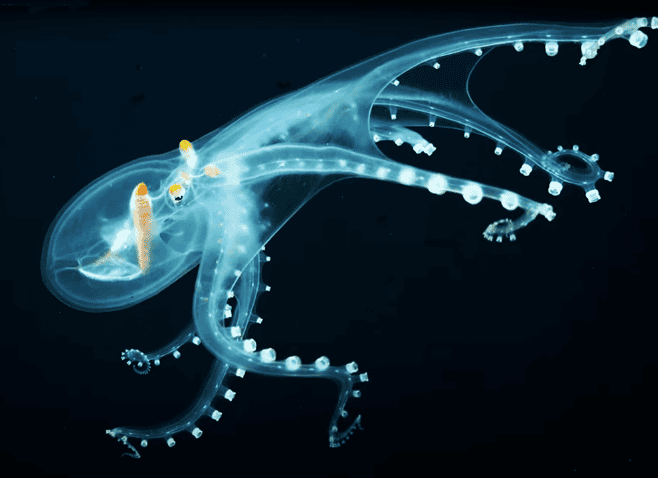The body of this rare glass octopus is completely transparent, and even its internal organs can be clearly seen. An underwater robot captured footage of it swimming gracefully in the deep waters of the central Pacific Ocean.
During a 34-day expedition, a team of researchers from the Schmidt Ocean Institute discovered this elusive species off the Phoenix Islands, 5,100 kilometers northeast of Sydney, Australia. The elusive glass octopus.

Glass octopus
Glass octopus (scientific name: Vitreledonella richardi) is a very rare species A cephalopod, this gelatinous octopus can grow up to 45 centimeters long - including its tentacles. They are mainly found in tropical and subtropical waters. The species is named for its nearly transparent body, which allows direct visualization of its optic nerve, eyes and digestive tract from outside the body.
Among the types of octopuses, the glass octopus belongs to the family Glass Octopus and is a type of octopus that is relatively difficult to find. On the one hand, this octopus lives in the deep sea, and on the other hand, it is With its transparent shape and difficult to photograph, it can be said that the glass octopus is one of the most mysterious animals in the world.
The body is transparent
The reason why the glass octopus can show a transparent appearance like glass is because there is almost no pigment inside its body. This feature allows light to penetrate their bodies without being absorbed or reflected, resulting in excellent invisibility.

The skin cells of glass octopuses are rich in water, giving their bodies a gel-like texture. Transparency is further enhanced. The formation of transparency is not entirely the result of natural selection, but gradually developed through a long evolutionary process.
It may not be correct to just think that they are for invisibility. After all, the deep sea is usually dark, and the eyes of many predators have also degraded. Whether they can be invisible is not particularly necessary. The transparent body seems to have no self-protection ability.
But there is no sunlight in the deep sea, and organisms do not need to rely on color to absorb sunlight and maintain body temperature. On the contrary, synthesizing pigment cells will consume more energy, so transparency is indeed a good choice.
The appearance of the glass octopus is one of its unique features, which has aroused the curiosity of scientists. In-depth study of its body structure and the formation principles of transparency can better understand the mystery of this deep-sea creature.
Predation methods
The glass octopus is a carnivore and feeds on other small marine organisms. Its hunting method is quite unique, usually using camouflage and ambush strategies.
Due to their transparent appearance, they can quietly approach their prey and then attack suddenly, using suction cups to secure their prey to their tentacles. This method of hunting requires a high degree of coordination and precision, making the glass octopus an elite among deep-sea predators.
The food sources of the glass octopus mainly include small fish, crustaceans, plankton and other deep-sea creatures. They usually feed on live or dead prey. Depending on the habitat, the type of food they choose also varies. will vary.
The uniqueness of its hunting method enables it to adapt to the changing food resources in the deep sea, making it one of the important chains in the ecosystem.
Light sensing organs are well developed
In the deep sea, the light gradually weakens and becomes darker as you go deeper. The glass octopus has very developed light-sensing organs, especially its large eyes. These large eyes have highly sensitive cones that allow them to detect faint light in the deep sea.
The existence of this light-sensing organ is crucial for the glass octopus to capture prey and avoid predators in the deep sea, and also provides it with an advantage in surviving in the dark abyss.

 扫一扫微信交流
扫一扫微信交流
发布评论